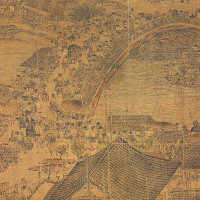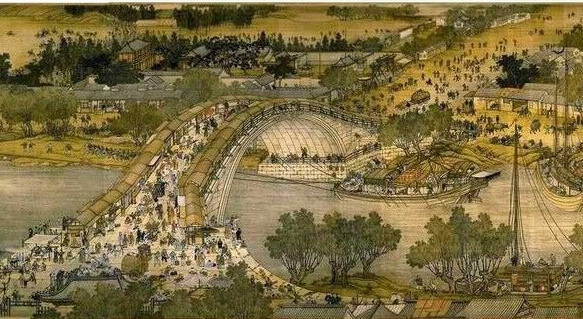 A famous ancient painting in China,The Qingming Festival by the Riverside, is a long, painted scroll 528 cm long and 24.8 cm wide, which portrays street scenes of Bianjing (today's Kaifeng City, Henan Province), the capital of the Northern Song Dynasty (960-1127).
A famous ancient painting in China,The Qingming Festival by the Riverside, is a long, painted scroll 528 cm long and 24.8 cm wide, which portrays street scenes of Bianjing (today's Kaifeng City, Henan Province), the capital of the Northern Song Dynasty (960-1127).
The work was created by Zhang Zeduan, a native of Shandong Province who studied painting in his early years in Bianjing. Later, Zhang became a painter for the Imperial Painting Academy of the Northern Song Dynasty. Although there aren't many historical records about Zhang, his name is remembered simply due to this masterpiece.
The oeuvre depicts the noisy streets of Bianjing during the Qingming Festival -- a festival for mourning ancestors -- at a time when the custom of going to street fairs was very popular. The painting features magnificent and complex scenes with a rigorous structure, which can be divided into three parts: scenes of the suburbs, Bian River and city streets.
In the suburban scene, farmers are working in the fields and wealthy people are returning from mourning. The street is crowded with people on horseback, wheel carts and sedan chairs.
 The scene of the Bian River is the most magnificent: The arched bridge stands like a rainbow over the river with streams of people bustling about. Under the bridge are many boats competing for the right of way. Some interesting scenes are presented in great detail. For instance, a horse has shied on the bridge, scaring a donkey and attracting many onlookers.
The scene of the Bian River is the most magnificent: The arched bridge stands like a rainbow over the river with streams of people bustling about. Under the bridge are many boats competing for the right of way. Some interesting scenes are presented in great detail. For instance, a horse has shied on the bridge, scaring a donkey and attracting many onlookers.
The importance of Bianjing as the political, economic and cultural center of the Northern Song Dynasty in the empire is fully depicted in the painting's city street scene. The streets are lined with government mansions, residential courtyards, workshops, teahouses and grocery stores. Various wagons and people from all walks of life can be seen in the picture, conveying an exciting and bustling atmosphere. The scenes in the picture are carefully arranged, forming an interesting contrast and good sense of rhythm. The depiction of the architecture, merchants and transportation in Bianjing vividly reflects the economic boom of the Northern Song Dynasty.
There are over 550 human figures, some 60 animals, 20 wooden boats, 30 rooms and pavilions, and about 20 vehicles of various kinds inThe Qingming Festival by the Riverside. Few ancient paintings contain such an abundance of rich contents. Furthermore, every figure and detailed scene is arranged strategically, creating chaos that appears to have some order to it. All such elements reveal the painter's careful observation of life and his supreme painting skills.
The Qingming Festival by the Riversideis a great and rare realistic painting that provides a vivid visual depiction of business, handicrafts, architecture and transport in the big metropolis of the Northern Song.
The piece is covered with innumerable signatures and seals, indicating that it has been in the hands of many private and official collectors. The painting survived many calamities and transitions, and was handed down by some collectors who sacrificed their lives to preserve this treasure.
 A famous ancient painting in China,The Qingming Festival by the Riverside, is a long, painted scroll 528 cm long and 24.8 cm wide, which portrays street scenes of Bianjing (today's Kaifeng City, Henan Province), the capital of the Northern Song Dynasty (960-1127).
A famous ancient painting in China,The Qingming Festival by the Riverside, is a long, painted scroll 528 cm long and 24.8 cm wide, which portrays street scenes of Bianjing (today's Kaifeng City, Henan Province), the capital of the Northern Song Dynasty (960-1127).
The work was created by Zhang Zeduan, a native of Shandong Province who studied painting in his early years in Bianjing. Later, Zhang became a painter for the Imperial Painting Academy of the Northern Song Dynasty. Although there aren't many historical records about Zhang, his name is remembered simply due to this masterpiece.
The oeuvre depicts the noisy streets of Bianjing during the Qingming Festival -- a festival for mourning ancestors -- at a time when the custom of going to street fairs was very popular. The painting features magnificent and complex scenes with a rigorous structure, which can be divided into three parts: scenes of the suburbs, Bian River and city streets.
In the suburban scene, farmers are working in the fields and wealthy people are returning from mourning. The street is crowded with people on horseback, wheel carts and sedan chairs.
 The scene of the Bian River is the most magnificent: The arched bridge stands like a rainbow over the river with streams of people bustling about. Under the bridge are many boats competing for the right of way. Some interesting scenes are presented in great detail. For instance, a horse has shied on the bridge, scaring a donkey and attracting many onlookers.
The scene of the Bian River is the most magnificent: The arched bridge stands like a rainbow over the river with streams of people bustling about. Under the bridge are many boats competing for the right of way. Some interesting scenes are presented in great detail. For instance, a horse has shied on the bridge, scaring a donkey and attracting many onlookers.
The importance of Bianjing as the political, economic and cultural center of the Northern Song Dynasty in the empire is fully depicted in the painting's city street scene. The streets are lined with government mansions, residential courtyards, workshops, teahouses and grocery stores. Various wagons and people from all walks of life can be seen in the picture, conveying an exciting and bustling atmosphere. The scenes in the picture are carefully arranged, forming an interesting contrast and good sense of rhythm. The depiction of the architecture, merchants and transportation in Bianjing vividly reflects the economic boom of the Northern Song Dynasty.
There are over 550 human figures, some 60 animals, 20 wooden boats, 30 rooms and pavilions, and about 20 vehicles of various kinds inThe Qingming Festival by the Riverside. Few ancient paintings contain such an abundance of rich contents. Furthermore, every figure and detailed scene is arranged strategically, creating chaos that appears to have some order to it. All such elements reveal the painter's careful observation of life and his supreme painting skills.

The Qingming Festival by the Riversideis a great and rare realistic painting that provides a vivid visual depiction of business, handicrafts, architecture and transport in the big metropolis of the Northern Song.
The piece is covered with innumerable signatures and seals, indicating that it has been in the hands of many private and official collectors. The painting survived many calamities and transitions, and was handed down by some collectors who sacrificed their lives to preserve this treasure.
